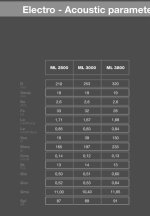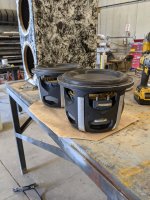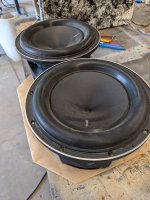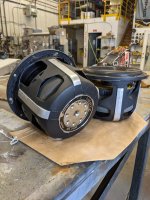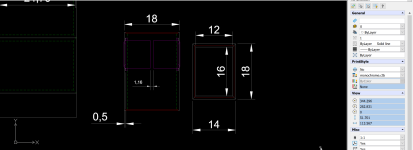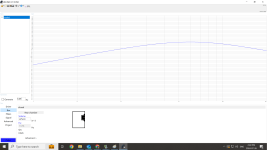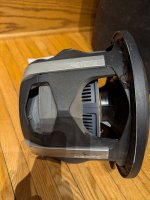Hey guys
I recently moved from my little apartment to a nice big house and I have been working on setting up a nice computer desk with some decent audio for gaming and music. I currently use a pair of KEF Q15 speakers on a small Fosi Audio V3 class D amplifier, these speakers sound pretty nice but they have very little bass to speak of.
I have a pair of Hertz ML2500 10" subwoofers leftover from my car audio days and was considering sticking them in a nice Acadia Wood box to match my desk. Way back when these were really expensive drivers and were considered top of the line so it would be nice if I could repurpose them assuming they'll work well in the application.
I managed to find what I believe is the correct TS parameters on an old forum post and ran a quick model in WinISD with a 1.5 cubic foot sealed box that looked pretty good. These are good looking drivers and it would be nice if I could put them to good use.
I recently moved from my little apartment to a nice big house and I have been working on setting up a nice computer desk with some decent audio for gaming and music. I currently use a pair of KEF Q15 speakers on a small Fosi Audio V3 class D amplifier, these speakers sound pretty nice but they have very little bass to speak of.
I have a pair of Hertz ML2500 10" subwoofers leftover from my car audio days and was considering sticking them in a nice Acadia Wood box to match my desk. Way back when these were really expensive drivers and were considered top of the line so it would be nice if I could repurpose them assuming they'll work well in the application.
I managed to find what I believe is the correct TS parameters on an old forum post and ran a quick model in WinISD with a 1.5 cubic foot sealed box that looked pretty good. These are good looking drivers and it would be nice if I could put them to good use.
Attachments
Very nice drivers that did well in SQ comps
I am currently trying to design some boxes for pro mobile subs such as yours, to bring them inside the home. Similar Vas and specs to the driver that I am using. Have a look in Volcano subwoofer’s thread
I will be building a dual opposed for my workstation for home studio mastering and video editing. You should be able to get a clean response from your drivers in a similar manner
I am currently trying to design some boxes for pro mobile subs such as yours, to bring them inside the home. Similar Vas and specs to the driver that I am using. Have a look in Volcano subwoofer’s thread
I will be building a dual opposed for my workstation for home studio mastering and video editing. You should be able to get a clean response from your drivers in a similar manner
@Randy Bassinga I was also thinking of of an opposed "push push" configuration, apparently there's some pretty good benefits from that configuration.
So looking at my model there's definitely no way I'll be able to mount these beefcake subwoofers magnet to magnet without really growing this enclosure. Is there any reason I can't do an offset push push design like I have modeled? Or will this negate the benefits?

Doing some more research I believe I answered my own question, it's definitely ideal to have both drivers inline with eachother. I also changed the material thickness from 1-1/2" thick panels to 1" simply due to material availability. The top and bottom panels have been changed to 3/8" laser cut steel so I can have them removable, I want to mount the drivers from the inside for a cleaner appearance. This has made the box grow a bit more than I'd like but I might just have to deal with it.
After the changes I get a box volume of 2.75 cubic feet not included driver displacement or bracing. Updated drawings and WinISD graphs are attached.
After the changes I get a box volume of 2.75 cubic feet not included driver displacement or bracing. Updated drawings and WinISD graphs are attached.
Attachments
FYI/FWIW, if the flared opening on the backside is a vent, then you'll ideally need at least a 0.61r pipe end correction gap to any parallel surface, so if back to back then 2x this distance.
r = radius of the entire flair in this case
r = radius of the entire flair in this case
FWIW, the Qts and intended use, it's best to use a sealed enclosure. Not only does it provide the most precise bass, it also most certainly compensates with its natural drop off with the room gain. Unless you really love and insist on a boomy, soft and diffuse bass, you should refrain on a vented enclosure, esp. on a driver with a that high Qts.
Hmm, just to be clear I was referring to placing the driver's vent, if that's what it is.
That's not wrong at all. However, in this special useage that probably calls for a different solution.
Is that how you found them to sound, did you listen for long? Even after properly breaking in? I didn't think there were too many others on here that would have also had long experience listening to this class of pro mobile drivers? Nobody ever seems to speak from first handlove and insist on a boomy, soft and diffuse bass, you should refrain on a vented enclosure, esp. on a driver with a that high Qts.
Did you find that the soft and diffuse presence emanating mostly from the port or diaphragm? Did you know that the pro mobile type of subs demand a much smaller box and that the box and port that created the boomy sound was just a bad design?
I have a mixer attached to my JLAudio 12W7 sub based system and it's ported but note perfect and sweet with the electric bass plugged into the car or the AKAI MPK Mini Plus. No boom, the sound and cone stops when I mute the string. Your box must be pretty off from what the driver needed
Is that how you found them to sound, did you listen for long? Even after properly breaking in? I didn't think there were too many others on here that would have also had long experience listening to this class of pro mobile drivers? Nobody ever seems to speak from first hand
I've built enough mobile speakers to get used to the initial hype but also the later request to tone it down, even when I wasn't the sound tech at the time. It can work but most sound tech fail at that point
Did you find that the soft and diffuse presence emanating mostly from the port or diaphragm? Did you know that the pro mobile type of subs demand a much smaller box and that the box and port that created the boomy sound was just a bad design?
"diffuse presence" may excite some HIFI freaks but should be avoided in PA at all costs. It's usually the result of a badly controlled dispersion, not a perk of the PA.
I have a mixer attached to my JLAudio 12W7 sub based system and it's ported but note perfect and sweet with the electric bass plugged into the car or the AKAI MPK Mini Plus. No boom, the sound and cone stops when I mute the string. Your box must be pretty off from what the driver needed
That's an issue with the music material, setup, signal chain and configuration. If that was an issue, maybe train the sound guy? Or don't give him a spot where he is responsible for everything but don't have the means or experience to change it. From what you are describing, the sound guy didn't have a chance to set it up properly or correct anything.
I had one of these mounted in a custom fiberglass box under the glove box in one of my cars years ago, it was a sealed design and I remember it sounding very nice but this was probably close to 10 years ago.
I had the pair of these mounted in a big vented enclosure a while back and I didn't think it sounded nearly as good as I was hoping it would, but again, this was a number of years ago and the box might not have been ideal.
For simplicity's sake I'm just going to do a sealed enclosure this time around. I attached some photos of how the driver is vented, my current drawing shows a 1" space between the magnets.
I had the pair of these mounted in a big vented enclosure a while back and I didn't think it sounded nearly as good as I was hoping it would, but again, this was a number of years ago and the box might not have been ideal.
For simplicity's sake I'm just going to do a sealed enclosure this time around. I attached some photos of how the driver is vented, my current drawing shows a 1" space between the magnets.
Attachments
Non responsive, please stay on topic.Maybe you need to cool down. But please don't jerk on that.
Those ML2500 subwoofer drivers appear to be very nice units, with lots of Xmax and a good power handling ability. The closed-box enclosure that is 1.5 cubic feet (42.5 litres) in net volume also seems quite reasonable. With the two drivers inside that enclosure, it's very close to a maximally-flat alignment.I have a pair of Hertz ML2500 10" subwoofers leftover from my car audio days and was considering sticking them in a nice Acadia Wood box to match my desk. Way back when these were really expensive drivers and were considered top of the line so it would be nice if I could repurpose them assuming they'll work well in the application.
I managed to find what I believe is the correct TS parameters on an old forum post and ran a quick model in WinISD with a 1.5 cubic foot sealed box that looked pretty good. These are good looking drivers and it would be nice if I could put them to good use.
@brandon3212276 Will you be using a plate subwoofer amplifier of some sort? If so, which one did you have in mind?
With a Linkwitz-Riley 4th-order low-pass filter in the signal chain, with its −6dB cut-off frequency set to 80Hz, the response of the twin-driver closed-box subwoofer will look something like what is shown below. Applying 300W re 8 ohms of input power, both drivers will reach 11mm of displacement at 20Hz, which is well below their Xmax of 19mm. The low-pass filtered response is −3dB at 36.2Hz.
If we add a 2nd-order high-pass peaking filter, set to 20Hz and Q = 2.0, we can get quite a bit more bass response out of the system. See the results shown below. This produces about 5dB more output at 20Hz than the un-EQed design shown above. Note that the slope between 25Hz and 45Hz is about 4dB per octave, which will blend in nicely with the room gain that occurs for a closed-box subwoofer. In this design, the response is −3dB at 29.1Hz, which is much lower than the 36.2Hz achieved in the previous design.
The filter settings are shown below.
Last edited:
The datasheet (PDF) says +/- 17mm Xmax (which is still huge).With a Linkwitz-Riley 4th-order low-pass filter in the signal chain, with its −6dB cut-off frequency set to 80Hz, the response of the twin-driver closed-box subwoofer will look something like what is shown below. Applying 300W re 8 ohms of input power, both drivers will reach 11mm of displacement at 20Hz, which is well below their Xmax of 19mm. The low-pass filtered response is −3dB at 36.2Hz.
- Home
- Loudspeakers
- Subwoofers
- PC desk subwoofer using car audio drivers
